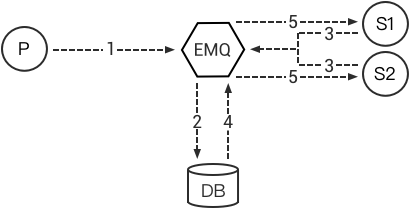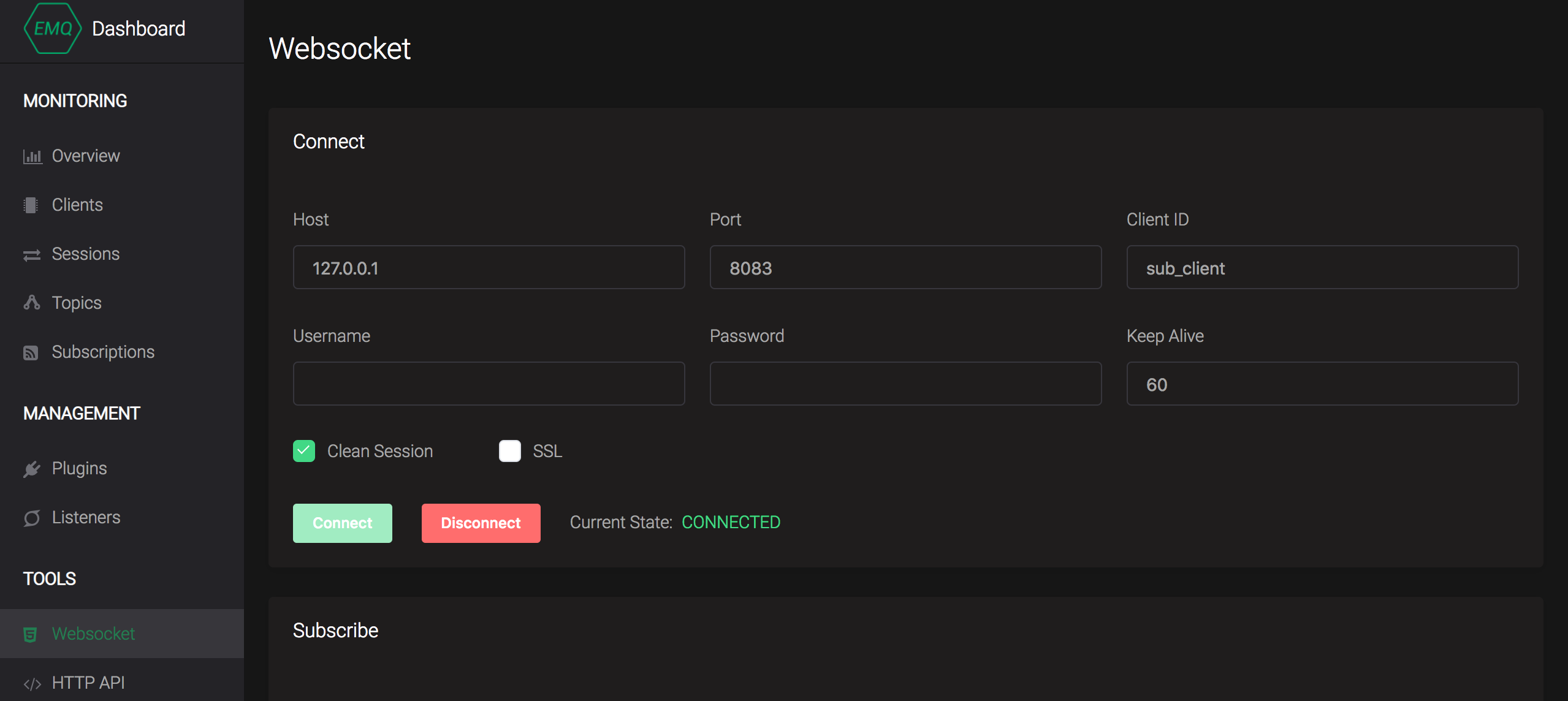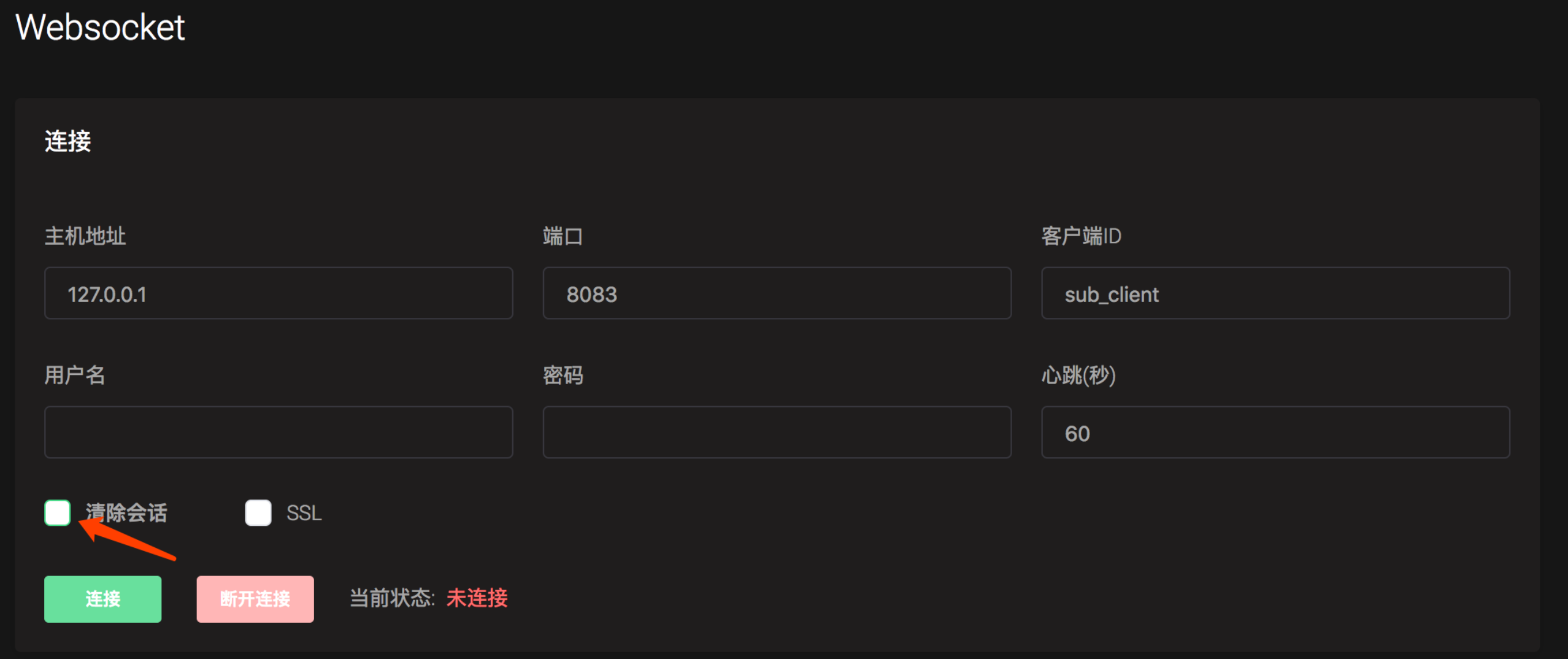Benutzer können ähnliche Funktionen auch durch das Abonnieren verwandter Themen erreichen, aber die in der Unternehmensversion integrierte Persistenzunterstützung ist effizienter und zuverlässiger, was die Arbeitsbelastung des Entwicklers erheblich reduziert und die Systemstabilität verbessert.
Datenpersistenz ist eine wichtige Funktion von EMQ X und wird nur in der Enterprise-Version unterstützt.Persistenzdesign
Einzelne Nachrichtenspeicherung


redis-server zu starten. ## Redis Server 127.0.0.1:6379, Redis Sentinel: 127.0.0.1:26379 backend.redis.pool1.server = 127.0.0.1:6379
emqx_ctl plugins load emqx_backend_redis
redis-server 命令来启动 Redis 服务器。通过 RPM 方式安装的 EMQ X,Redis 相关的配置文件位于 /etc/emqx/plugins/emqx_backend_redis.conf,如果只是测试 Redis 持久化的功能,大部分配置不需要做更改。唯一需要更改的地方可能是 Redis 服务器的地址:如果读者安装的 Redis 不与 EMQ X 在同一服务器上,请指定正确的 Redis 服务器的地址与端口。如下所示:
## 上线
backend.redis.hook.client.connected.1 = { "action": { "function": "on_client_connected" }, "pool": "pool1"}
## 下线
backend.redis.hook.client.disconnected.1 = {"action": {"function": "on_client_disconnected"}, "pool": "pool1"}保持剩下部分的配置文件不变,然后启动该插件:
127.0.0.1:6379> keys * 1) "mqtt:node:emqx@127.0.0.1" 2) "mqtt:client:sub_client"
客户端上下线时,更新在线状态、上下线时间、节点客户端列表至 Redis 数据库。
尽管 EMQ X 本身提供了设备在线状态 API,但在需要频繁获取客户端在线状态、上下线时间的场景下,直接从数据库获取该记录比调用 EMQ X API 更高效。
打开配置文件,配置 Backend 规则:
## redis key 为 mqtt:node:{node_name}
HMSET mqtt:node:emqx@127.0.0.1 sub_client 1542272836浏览器打开 http://127.0.0.1:18083 EMQ X 管理控制台,在 工具 -> Websocket 中新建一个客户端连接,指定 clientid 为 sub_client:

打开 redis-cli 命令行窗口,执行命令 keys *Client-Online-Statusspeicher
## 节点下在线设备信息 127.0.0.1:6379> HGETALL mqtt:node:emqx@127.0.0.1 1) "sub_client1" # clientid 2) "1542272836" # 上线时间时间戳 3) "sub_client" 4) "1542272836"
http://127.0.0.1:18083 EMQ X-Verwaltungskonsole in Tools -> Websocket Erstellen Sie eine neue Client-Verbindung und geben Sie die Client-ID als sub_client an:🎜🎜
插件以 mqtt:sub:{client_id} 格式 key 在 Redis 中初始化代理订阅 Hash:
## redis key 为 mqtt:sub:{client_id}
## HSET key {topic} {qos}
127.0.0.1:6379> HSET mqtt:sub:sub_client sub_client/upstream 1
(integer) 0
127.0.0.1:6379> HSET mqtt:sub:sub_client sub_client/downlink 1
(integer) 0EMQ X 管理控制台 WebSocket 页面,以 clientid sub_client 新建一个客户端连接,切换至订阅页面,可见当前客户端自动订阅了 sub_client/upstream 与 sub_client/downlink 两个 QoS 1 的主题:

切换回管理控制台 WebSocket 页面,向 sub_client/downlink 主题发布消息,可在消息订阅列表收到发布的消息。
打开配置文件,配置 Backend 规则,支持使用 topic 参数进行消息过滤,此处使用 # 通配符存储任意主题消息:
## hook: message.publish
## action/function: on_message_publish
backend.redis.hook.message.publish.1 = {"topic": "#", "action": {"function": "on_message_publish"}, "pool": "pool1"}在 EMQ X 管理控制台 WebSocket 页面中,使用 clientid sub_client 建立连接,向主题 upstream_topic 发布多条消息。针对每条消息, EMQ X 将持久化消息列表、消息详情两条记录。
EMQ X 将消息列表以 message id 持久化至 mqtt:msg:{topic} Redis 集合中:
## 获取 upstream_topic 主题集合中所有 message id 127.0.0.1:6379> ZRANGE mqtt:msg:upstream_topic 0 -1 1) "2VFsyhDm0cPIQvnY9osj" 2) "2VFszTClyjpVtLDLrn1u" 3) "2VFszozkwkYOcbEy8QN9" 4) "2VFszpEc7DfbEqC97I3g" 5) "2VFszpSzRviADmcOeuXd" 6) "2VFszpm3kvvLkJTcdmGU" 7) "2VFt0kuNrOktefX6m4nP" 127.0.0.1:6379>
每条消息详情将以 mqtt:msg:{message_id} 格式的 key 存储在 Redis Hash 中:
## 获取 message id 为 2VFt0kuNrOktefX6m4nP 的消息详情
127.0.0.1:6379> HGETALL mqtt:msg:2VFt0kuNrOktefX6m4nP
1) "id"
2) "2VFt0kuNrOktefX6m4nP" ## message id
3) "from"
4) "sub_client" ## client id
5) "qos"
6) "2"
7) "topic"
8) "up/upstream_topic"
9) "payload"
10) "{ "cmd": "reboot" }"
11) "ts"
12) "1542338754" ## pub 时间戳
13) "retain"
14) "false"打开配置文件,配置 Backend 规则:
## hook: session.subscribed
## action/function: on_message_fetch_for_queue、on_message_fetch_for_pubsub
## 一对一离线消息
backend.redis.hook.session.subscribed.1 = {"topic": "queue/#", "action": {"function": "on_message_fetch_for_queue"}, "pool": "pool1"}
## 一对多离线消息
backend.redis.hook.session.subscribed.2 = {"topic": "pubsub/#", "action": {"function": "on_message_fetch_for_pubsub"}, "pool": "pool1"}MQTT 离线消息需满足以下条件:
以 clean_session = false 连接
订阅 QoS > 0
发布 QoS > 0
在 EMQ X 管理控制台中以如下配置建立连接,

打开配置文件,配置 Backend 规则:
## hook: message.publish
## action/function: on_client_connected、on_message_retain
backend.redis.hook.message.publish.2 = {"topic": "#", "action": {"function": "on_message_retain"}, "pool": "pool1"}
backend.redis.hook.message.publish.3 = {"topic": "#", "action": {"function": "on_retain_delete"}, "pool": "pool1"}EMQ X 将消息列表以 message id 持久化至 mqtt:retain:{topic} Redis Hash 中:
## 获取 upstream_topic 主题集合中所有 message id 127.0.0.1:6379> ZRANGE mqtt:retain:upstream_topic 0 -1 1) "2VFsyhDm0cPIQvnY9osj" 127.0.0.1:6379>
每条消息详情将以 mqtt:msg:{message_id} 格式的 key 存储在 Redis Hash 中:
## 获取 message id 为 2VFt0kuNrOktefX6m4nP 的消息详情
127.0.0.1:6379> HGETALL mqtt:msg:2VFt0kuNrOktefX6m4nP
1) "id"
2) "2VFt0kuNrOktefX6m4nP" ## message id
3) "from"
4) "sub_client" ## client id
5) "qos"
6) "2"
7) "topic"
8) "up/upstream_topic"
9) "payload"
10) "{ "cmd": "reboot" }"
11) "ts"
12) "1542338754" ## pub 时间戳
13) "retain"
14) "false"Das obige ist der detaillierte Inhalt vonSo implementieren Sie EMQ X Redis-Datenpersistenz. Für weitere Informationen folgen Sie bitte anderen verwandten Artikeln auf der PHP chinesischen Website!
 Häufig verwendete Datenbanksoftware
Häufig verwendete Datenbanksoftware
 Was sind In-Memory-Datenbanken?
Was sind In-Memory-Datenbanken?
 Welches hat eine schnellere Lesegeschwindigkeit, Mongodb oder Redis?
Welches hat eine schnellere Lesegeschwindigkeit, Mongodb oder Redis?
 So verwenden Sie Redis als Cache-Server
So verwenden Sie Redis als Cache-Server
 Wie Redis die Datenkonsistenz löst
Wie Redis die Datenkonsistenz löst
 Wie stellen MySQL und Redis die Konsistenz beim doppelten Schreiben sicher?
Wie stellen MySQL und Redis die Konsistenz beim doppelten Schreiben sicher?
 Welche Daten speichert der Redis-Cache im Allgemeinen?
Welche Daten speichert der Redis-Cache im Allgemeinen?
 Was sind die 8 Datentypen von Redis?
Was sind die 8 Datentypen von Redis?




